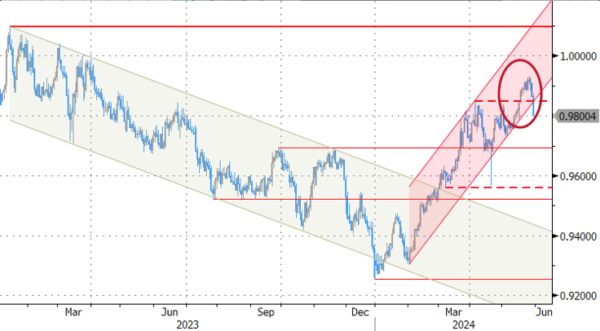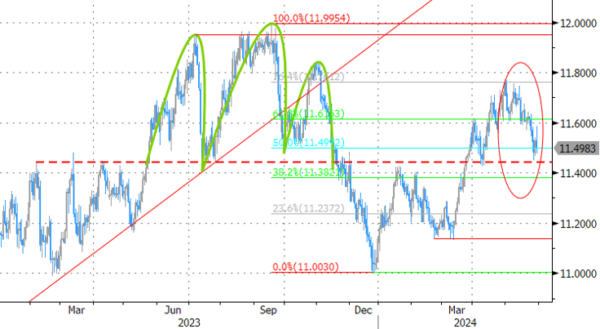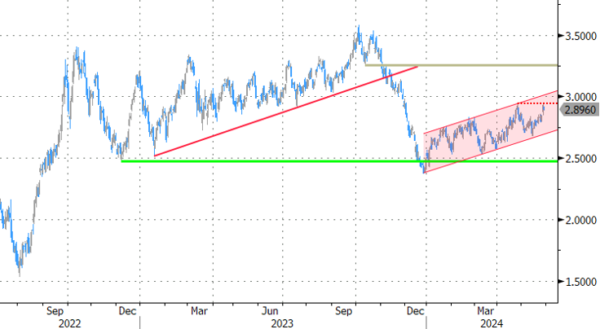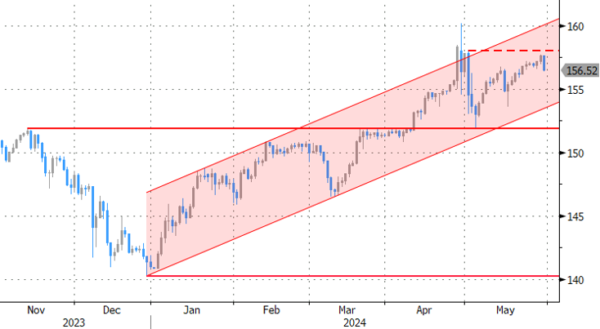Markets
The two-day sell-off on core bond markets slightly went into reverse today. A downward revision to US Q1 price deflators (core PCE 3.6% Q/Q from 3.7%) and Q1 personal consumption (2% Q/Q from 2.5%) triggered the leap higher in which US Treasuries outperform German Bunds. Weekly jobless claims continue to hover near extremely low levels (219k from 216k) but didn’t have any market impact. US yields currently lose 4.2 bps to 5.7 bps with the belly of the curve outperforming the wings. Changes on the German curve were much more modest, varying between -1 bp to -2 bps. European data showed near consensus Spanish CPI (3.8% Y/Y for headline and 3% Y/Y for core) and an unexpected decline in April EMU unemployment rate (6.4% from 6.5%, lowest level since 1999). ECB members are already in their quiet period ahead of next week’s policy meeting. The blackout for the Fed starts this weekend with a potentially final significant appearance by NY Fed Williams at the Economic Club of New York later today. We especially look for views on the level of the neutral rate, once labelled the “phantom menace” by former St-Louis Fed governor Bullard. Heavyweight Fed governor Waller last week stressed that market perception on this theoretical equilibrium rate is too low and below levels where the Fed sees it (2.5%-3%). It’s one of the reasons why he thinks long term rates should be higher. An acknowledgement of a higher neutral in the June dot plot could serve as a new wake-up call to investors. Loss of interest rate support pulled the dollar away from first minor resistance levels. The trade-weighted dollar (DXY) failed to move beyond 105.12 (last week’s high) with return action to currently 104.77. EUR/USD similarly bounced off the 1.08-area to change hands at 1.0827. EUR/GBP holds dangerously close to the 0.85 support zone. The lack of BoE-speeches and UK eco data planned in coming days suggests that this bottom will hold for at least a little bit longer.
News & Views
The economic barometer of the Swiss KOF Economic Institute unexpectedly softened in May from 101.9 to 100.3 (vs 102.1 expected). The Institute labelled the outcome as a muted momentum. The index this year only managed to stay very slightly above its medium-term average. The indicator bundles for manufacturing, financial and insurance services and foreign demand slowed down in May after having recorded positive developments in the previous month. Especially the manufacturing sector showed broad-based weakness. The indicators for private consumption and the construction industry cushioned the decline with increases. A separate data release from the Swiss State Secretariate of economic affairs, upwardly revised Q1 economic growth to 0.5% Q/Q, up from 0.3% in Q4 2023. Adjusted for the turnover of global sport organizations such as OIC, FIFA en UEFA, the GDP pace remained stable at 0.3% Q/Q. Growth was mainly driven by solid private consumption (+0.4%) and investment in equipment (+0.8%, a first rise after three negative quarters). Foreign trade negatively contributed to growth as strong imports (+2%), coincided with lackluster exports (goods -3.3%, services +1%). The Swiss franc rebounded sharply today, but this was mainly due to SNB Jordan signaling that the recent correction of the franc has gone far enough. EUR/CHF lost one big figure over the past two trading sessions, from 0.99 to 0.98.
Belgian CPI inflation rose in May by 0.37% M/M, leaving the Y/Y measure almost unchanged at 3.37%. Compared to April, the most significant price increases were registered for fruit (4.7%), clothes (1.3%), rents (0.6%), travels abroad and city trips (1.8%) and restaurants and cafés (0.5%). Motor fuels (-2.3%), electricity (-2.9%) and vegetables (-1.3%) had a decreasing effect on the index M/M. Compared to the same month last year, services inflation eased to 3.88% Y/Y from 4.93%. Food inflation increased slightly to 1% Y/Y from 0.25% in March and compared with a 17.02% peak in March 2023. Energy inflation continues to rise, from 9.19% to 11.17% Y/Y and accounts for 0.95 ppts in total inflation. The rise in inflation in recent months is due to the phase-out of the impact of the basic package for electricity and natural gas. Core inflation excluding prices of energy and unprocessed food, slowed to 2.8% Y/Y from 3.26% and 3.85% in April and March respectively. The first inflation estimate according to the European harmonized index of consumer prices (HICP flash estimate) for Belgium amounts 4.9% Y/Y.
Graphs
EUR/CHF: enough is enough for SNB Jordan

EUR/SEK: SEK profits slightly from Q1 GDP beat (+0.7% Q/Q) which was mainly driven by inventory build-up though

EU10y swap rate: previous YTD top holds, for now

USD/JPY: Japenese MoF officials saved by today’s correction in lower core bond yields










